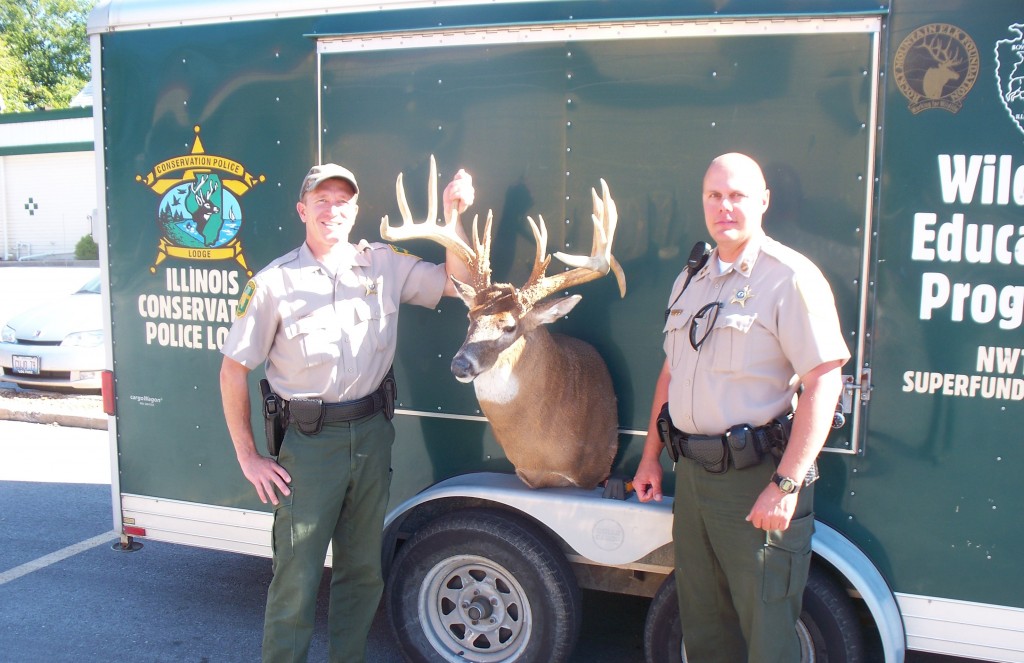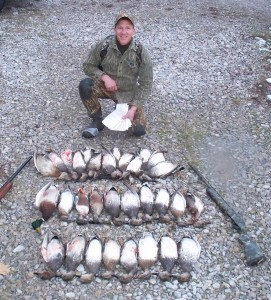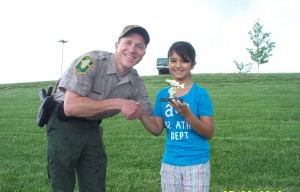Illinois Conservation Police’s Mission Is To Preserve Natural Habitats

Public programs on resource conservation and recreational safety are key tasks for Conservation Police Officers, like 2012 CPO of the year Don Schachner, left. Photo courtesy IDNR.
On a bright morning in late spring:
The hawk circles slowly, its red tail feathers turned bright copper by the sun’s glinting rays. This bird hunts not only to satisfy it’s own hunger but also to meet the demands of his mate and the chicks they care for. Keen eyesight, wings and tail structured for speed and agility, and talons, sharp and capable of quick capture, should render this red-tailed hawk and his slightly larger mate the ability to feed, raise and fledge their three chicks. He isn’t terribly choosy about what he hunts, opportunistically taking what’s most abundant and available: mainly rodents such as rats and mice, snakes, the occasional bird, even carrion during the scarce months of winter.
His flight carries him over watching people. They, too, are opportunists and choose their prey as it presents itself: a “chicken-hawk” flying at easy range. One shoots and the hawk falls. Bragging rights bagged, the shooter and companion walk away. A week later the last of the three hawk chicks dies because the female could not alone meet the imperatives of raising young.
Some distance away a fawn, dappled with spots and sunlight, lies down in a flower patch. Following her nose and interest in discovery she has wandered about 50 feet from where her mother left her that morning. Instinct and tiredness from this day’s exploration tells the fawn to be quiet and still, to let discoveries – like the bright sulfur-colored butterfly nectaring on a flower near her nose — come to her.
People also watch the fawn. Unlike the hawk shooters these people do not see prey, instead perceiving a young animal, the very essence of babydom’s cuteness and helplessness, abandoned by its mother. After a stealthy approach they place a pet collar and leash on the fawn and lead it home, satisfying their feelings and need to do “something” about the cruelty of nature and the apparent irrational irresponsibility of one doe in particular. They happily gather milk-filled bottles, cooing over and patting the fawn as they debate names for their new “pet.”
In the woods the doe browses contentedly, nipping an oak tree sprout, munching spicebush leaves and grass shoots. Abundant food and water have kept her healthy and well able to supply her fawn with milk. Startled from her browsing at the approach of a human, she bounds through the underbrush, ready to return to her fawn and eager to be relieved of the burden of her milk.
The person hikes through the woods, paying no attention to the sound of the doe’s departure. Head down, eyes sweeping the forest floor for another sort of prey, the hiker drops to one knee simultaneously pulling a hand trowel from a back pocket. The small patch of ginseng is quickly uprooted, leaves and stems torn off and discarded, the roots stowed in a hand sack. Pulling ‘sang provides a unique satisfaction to this hiker: a “free” product of nature to be sold to a root buyer who isn’t terribly particular about the source of his trades.
Each action – inspired by desires to shoot and brag, capture and cuddle, pull and profit – is theft. Theft not only from “nature” but thievery from all the rest of us. This robbery – whether of game or non-game animals, wildlife and natural resources of any sort – deprives us and future generations of legitimate sporting activities and associated revenues, and the enjoyment of wildlife and intact natural resources.
Early in our state’s history, Illinoisans recognized the need to protect natural resources. The very first “Game Wardens” were appointed by the Governor in 1885 and confined their activities to enforcing game law violations; by 1911 fisheries’ laws were enacted and enforced by a separate corps of “Fish Wardens.” The two forces were joined together in 1917 and, in 1928, the renamed “Division of Law Enforcement” was incorporated into the newly created Department of Conservation. Through the last century a variety of policing powers were added to the duties of the Conservation Police Officer (CPO) and, today, CPOs have full police authority to enforce all Illinois Compiled Statutes. In 1995 several additional departments were merged and the Department of Conservation became today’s Illinois Department of Natural Resources. Unchanged is the scope and focus of enforcement duties: while IDNR’s CPOs can – and do – respond to traffic violations, their primary focus remains the laws and activities regarding natural resource protection and recreational safety.

Checking to see if hunters have taken more than the allowable limit of game is one of the many duties Illinois Department of Natural Resources Conservation Police Officers do. Photo courtesy IDNR.
CPO Don Schachner, assigned to IDNR’s administrative Region IV, watches over all aspects of our bluff lands’ natural resources. Schachner was named the 2012 CPO of the year, leading his region in enforcement actions including arrests for operating under the influence (OUI), felony resource theft, and hunting wild turkeys without a permit. A 13-year veteran of IDNR’s Conservation Police, Officer Schachner is well versed in all aspects of his work, speaking knowledgably about regulations regarding timber harvest, hunting seasons, takings permits, and the need to work with the public to educate and enlist their help to stop poaching activities and keep recreation safe for all.
The wildlife and conservation chapters within the Illinois Compiled Statutes carefully detail the protection of natural resources and define permissible and impermissible actions covering all wildlife and habitat concerns: mammals, birds, fish, natural areas preservation, plants, caves and forestry, and additional resources. Rules and regulations covering licensing and permitting, hunting, trapping, and fishing seasons and the full host of recreational activities we enjoy protect natural resources for all of us.
Faced with the above scenarios, Schachner noted that a CPO could issue a simple warning, but, depending on his or her determination of the offense and the person’s actions and history of prior violations of the law, far more serious actions could be taken. The CPO could write tickets, require a court appearance and payment of fines, and, through documentation of the offense, ensure that the offender’s license be revoked.
Both Illinois and federal statutory law protect non-game birds, especially birds of prey, from nearly all human interference. In nearly all cases it is simply illegal to harm or harass birds; to possess wild birds, their bodies or even body parts; capturing a bird or releasing a captive bird also is illegal. Similar restrictions govern additional wildlife, including both game and non-game animals.
Exceptions are allowed but depend on additional considerations. Scaring and “shooing” flocks of birds, such as grackles, blackbirds, cowbirds and starlings, that are damaging crops or other valuable material are an exception to the general “don’t bother them” nature of the rules. Permits may be granted by authorized agencies for scientific research purposes, so long as those purposes are fully detailed and the research would not otherwise be possible. A landowner faced with a genuine nuisance animal may seek a permit allowing the killing of a pest. Before such a permit can be issued a CPO and/or a wildlife biologist would investigate to determine if any solution short of a special kill permit is possible. Schachner noted that investigators would inspect the security and protection provided by livestock pens before recommending the issuance of a nuisance permit, using an example of a great-horned owl dining nightly on chickens. If the owners of the chickens were to insist that their birds be allowed to “free range” without benefit of a protective coop, a CPO or wildlife biologist undoubtedly would counsel them that their nightly setting an attractive, accessible, and well-stocked larder had trained the owl to return and that such baiting of wildlife is an illegal act subject to fines and penalties.

Conservation Police Officers enjoy the opportunity to help the public learn more about our state's natural resources. Photo courtesy IDNR.
The fawn, too, is protected under law, for the capture and holding of wildlife is simply illegal. Licensed wildlife rehabilitators are permitted to hold, treat and care for injured animals. Even the ginseng patch and roots are protected under law to ensure the continued survival of this plant, used in various folk remedies. Ginseng collection for sale is legal during the autumn, so long as collectors have a valid permit, the landowner’s permission to gather on their property, and the collector harvests in such a manner that ensures the continuation of the species. Root buyers must document and retain records of such purchases, send required reports and make records available to enforcement authorities upon request.
Protecting our state’s natural resources benefits all of us and helps preserve the legacy we pass to future generations.
CPO Schachner presented a program – and took questions about his duties — on conservation law enforcement for the October meeting of the Kaskaskia Valley Audubon Society. This meeting was co-sponsored by Clifftop on Thursday October 17that the First Baptist Church, 1010 Locust Street (Locust & West Field Drive), Red Bud.
CLIFFTOP, a local nonprofit organization, is focused on preserving and protecting area bluff lands.
A version of this article appeared in the 4 October 2013 edition of the Monroe County Independent.
© 2013 all content rights reserved Clifftop NFP
Comments are currently closed.
